|
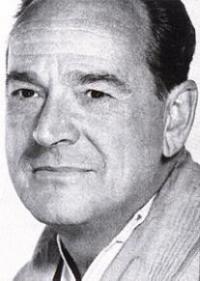 One of the
all time most consistently outstanding film directors, Anthony Mann's action/suspense films continually returned to the theme of
"intelligent, thoughtful men driven to violence." Heroes in Mann movies relentlessly pursued justice, breaking the law along
the way if need be. Arguably the premier American film noir director, with its shadows and darkness, Mann also virtually invented 'western
noir', where sprawling, bright landscapes contrasted with the dark, personal struggles. His 1950s westerns nearly single-handedly rescued
the western genre from jokey oblivion. Despite all this, and the immediate familiarity of many of his films, Mann is relatively unknown today. One of the
all time most consistently outstanding film directors, Anthony Mann's action/suspense films continually returned to the theme of
"intelligent, thoughtful men driven to violence." Heroes in Mann movies relentlessly pursued justice, breaking the law along
the way if need be. Arguably the premier American film noir director, with its shadows and darkness, Mann also virtually invented 'western
noir', where sprawling, bright landscapes contrasted with the dark, personal struggles. His 1950s westerns nearly single-handedly rescued
the western genre from jokey oblivion. Despite all this, and the immediate familiarity of many of his films, Mann is relatively unknown today.
Many of Mannís films were written by Borden Chase (who also wrote Red River, Vera Cruz and more) or John Higgins (Kid Glove Killer, the classic
Adventures of Tartu and Robinson Crusoe on Mars). Mann brought a writer's sensibility
to his filmmaking. His pictures look and move with incredible precision, AND they told fantastic stories. (Mann also wrote for films he
did not direct himself, most notably Follow Me Quietly, directed by Richard Fleischer).
More than twenty Mann movies rate three stars or better, including a handful of the best films of his generation. This list is my
suggestions on how to begin to explore the films of Anthony Mann.
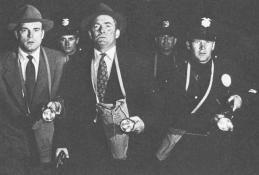
 1)He Walked by Night,
1948. Anthony Mann isnít even credited as the director, but the scenes he filmed are unmistakable. The sequences of Richard Basehart
running through the Los Angeles sewers are some of the most arresting visuals ever captured on film. Not only are the shots clever and
technically impressive, they literally tell the story on several levels. Sometimes movies have perfect scenes that are essentially
accidents. But here they are a deliberate choice. Besides these justifiably famous scenes, He Walked by Night is an important
film for itís portrayal of a brilliant, completely amoral villain as well as itís depiction of solid police work in rooting out the
villain's identity. Not coincidentally, Jack Webb has a supporting role, and it was the principal inspiration for
Dragnet. Basehart and star Scott Brady are excellent. 1)He Walked by Night,
1948. Anthony Mann isnít even credited as the director, but the scenes he filmed are unmistakable. The sequences of Richard Basehart
running through the Los Angeles sewers are some of the most arresting visuals ever captured on film. Not only are the shots clever and
technically impressive, they literally tell the story on several levels. Sometimes movies have perfect scenes that are essentially
accidents. But here they are a deliberate choice. Besides these justifiably famous scenes, He Walked by Night is an important
film for itís portrayal of a brilliant, completely amoral villain as well as itís depiction of solid police work in rooting out the
villain's identity. Not coincidentally, Jack Webb has a supporting role, and it was the principal inspiration for
Dragnet. Basehart and star Scott Brady are excellent.
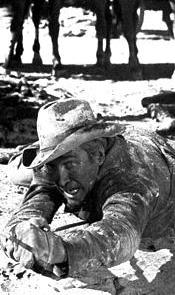 2) Winchester '73, 1950.
While this film is credited with reviving the serious western, looking back on it today, its even greater legacy is its reinvention of
Jimmy Stewart. Prior to this film, Stewart had already done crime films like Rope and Call Northside 777 in addition to
his more famous Frank Capra roles, but here America saw Jimmy Stewart as they had never seen him before -- cynical, angry, even
outright ruthless. Watch the scene where Stewart is about to brutally break Dan Duryeaís arm, his eyes exploding out of his head, wild
with pure rage, then imagine what the desperate lead characters in Mr. Smith Goes to Washington or It's a Wonderful Life
could have been capable of. 2) Winchester '73, 1950.
While this film is credited with reviving the serious western, looking back on it today, its even greater legacy is its reinvention of
Jimmy Stewart. Prior to this film, Stewart had already done crime films like Rope and Call Northside 777 in addition to
his more famous Frank Capra roles, but here America saw Jimmy Stewart as they had never seen him before -- cynical, angry, even
outright ruthless. Watch the scene where Stewart is about to brutally break Dan Duryeaís arm, his eyes exploding out of his head, wild
with pure rage, then imagine what the desperate lead characters in Mr. Smith Goes to Washington or It's a Wonderful Life
could have been capable of.
Amazingly this scene is not even the most memorable one in the film -- and its not even second! The first
occurs when Stewart happens on the man he has been stalking, Dutch Henry Brown. When they see each other, Stewart and Dutch Henry
(played by Stephen McNally) both bolt to their feet and instinctively grab for their guns -- but they are in Dodge City and Wyatt Earp
has disarmed them both. They are both left with "if looks could kill" looks on their faces. The other scene to watch for could
well be the single most cowardly act ever put on film.
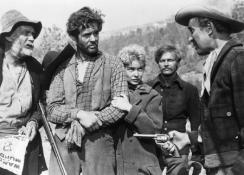 3) The Naked Spur, 1953. Jimmy Stewart made eight films with Anthony Mann. Five were westerns. Many film critics consider The Naked Spur to be the
finest western ever made. Besides Stewart there are four other characters, played by Robert Ryan, Janet Leigh, Millard Mitchell (also
in Winchester '73) and the always watchable Ralph Meeker (memorable in Jeopardy and as Mike Hammer in
Kiss Me Deadly). Technically Ryan is the villain,
but each male character is nuts in his way. Meeker in particular personifies heroic villainy, if that is possible. When watching the
sunny, breathtaking scenery of The Naked Spur, I always think of the darkness of Mann's film noir movies. Mann's command of
both dark and panoramic light is an amazing accomplishment. 3) The Naked Spur, 1953. Jimmy Stewart made eight films with Anthony Mann. Five were westerns. Many film critics consider The Naked Spur to be the
finest western ever made. Besides Stewart there are four other characters, played by Robert Ryan, Janet Leigh, Millard Mitchell (also
in Winchester '73) and the always watchable Ralph Meeker (memorable in Jeopardy and as Mike Hammer in
Kiss Me Deadly). Technically Ryan is the villain,
but each male character is nuts in his way. Meeker in particular personifies heroic villainy, if that is possible. When watching the
sunny, breathtaking scenery of The Naked Spur, I always think of the darkness of Mann's film noir movies. Mann's command of
both dark and panoramic light is an amazing accomplishment.
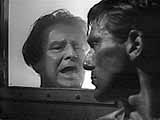 4) T-Men, 1947. T-Men are
Treasury agents after an atypical counterfeiting ring. In much the same way as a tribe is known by the strength of its enemies, Mannís
heroes stand taller because his villains are so strong, clever and utterly ruthless. Dennis OíKeefe stars with Charles McGraw as a
creepy, sadistic killer. (See McGraw in the exciting Narrow Margin for a look at him as a hero.) Considering Mann also made
Desperate and Railroaded in 1947, you have to wonder if he was in the shadows all year long. T-Men features the first
kill-the-guy-in-the-Turkish-bath movie scene, and a terrifically effective scene featuring the minor character "Paul Miller"
that again emphasizes the clever, confident nature of an Anthony Mann villain. 4) T-Men, 1947. T-Men are
Treasury agents after an atypical counterfeiting ring. In much the same way as a tribe is known by the strength of its enemies, Mannís
heroes stand taller because his villains are so strong, clever and utterly ruthless. Dennis OíKeefe stars with Charles McGraw as a
creepy, sadistic killer. (See McGraw in the exciting Narrow Margin for a look at him as a hero.) Considering Mann also made
Desperate and Railroaded in 1947, you have to wonder if he was in the shadows all year long. T-Men features the first
kill-the-guy-in-the-Turkish-bath movie scene, and a terrifically effective scene featuring the minor character "Paul Miller"
that again emphasizes the clever, confident nature of an Anthony Mann villain.
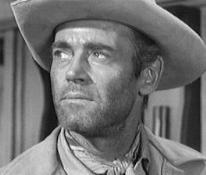 5) The Tin Star, 1957.
Henry Fonda slips into the Jimmy Stewart role after Stewart and Mann had a falling out that led to the end of their collaboration.
Fonda never seems as ruthless as Stewart, but he manages to convey even more world-weary cynicism. As usual, Mann surrounds himself
with a terrific cast including Anthony Perkins, Lee Van Cleef and one of the best performances of the magnetic Neville Brand. Bounty hunter Fonda when confronted by the menacing Brand after bringing Brandís no-good cousin in dead:
"Every family has a black sheep... some have two." 5) The Tin Star, 1957.
Henry Fonda slips into the Jimmy Stewart role after Stewart and Mann had a falling out that led to the end of their collaboration.
Fonda never seems as ruthless as Stewart, but he manages to convey even more world-weary cynicism. As usual, Mann surrounds himself
with a terrific cast including Anthony Perkins, Lee Van Cleef and one of the best performances of the magnetic Neville Brand. Bounty hunter Fonda when confronted by the menacing Brand after bringing Brandís no-good cousin in dead:
"Every family has a black sheep... some have two."
6) Raw Deal, 1948. Here we discover something Anthony Mann loves to film as much as shadows: co-star Marsha Huntís face. Aside
from how beautiful it is, one reason may be because she is the only sympathetic character in this film -- and she isnít even the most
likeable! (That honor goes to the #2 villain played by John Ireland.) The lead bad guy here is perhaps the heaviest heavy in the history
of American film: Raymond Burr. Perry Mason fans unfamiliar with Burrís film noir work are in for a jolt here when he throws burning
alcohol on a party guest when she accidentally bumps him: "She should have been more careful." True to Anthony Mann movies
though, that scene isnít the creepiest. That distinction goes to John Ireland and the deer antlers... YOW!
7) The Tall Target, 1951. One of my favorite actors of the noir era is
Dick Powell. Like Stewart, Powell similarly
transformed his career, from a song-and-dance man to being one of the all-time great movie tough guys (Murder My Sweet,
Cornered, Cry Danger, and more). Here Powell plays a policeman out to foil an assassination attempt on Abraham Lincoln
in 1861 before his inauguration as President. Difficult times full of both clever treachery and false honor are convincingly depicted.
Even better is Powellís explanation about why he is trying so desperately to save Lincolnís life. And in one of those Twilight
Zone-like coincidences, Powell's character's name is... John Kennedy.
8) The Man from Laramie, 1955. Jimmy Stewart again, this time single-mindedly hunting for the person ultimately responsible for
the death of his brother. In a memorable scene, Wallace Ford (notable as "The Schemer" in T-Men), the closest thing to
a friend Stewart has in the film, tells him: "Hate is unbecoming on some men, Mr. Lockhart. On some men it shows."
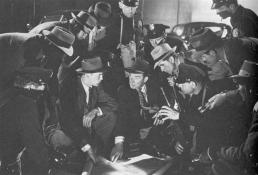 9) Desperate, 1947.
Mannís run of film noir gems began here. All the elements he perfected later are here, including evil personified in Raymond Burr,
as a brother-obsessed gangster. This film could have made impossibly beautiful
Audrey Long (see her in the very underrated Game of Death
and Born to Kill) a big star if every third word out of her mouth wasnít her dopey husbandís name! It gets to be like fingers on a chalkboard. 9) Desperate, 1947.
Mannís run of film noir gems began here. All the elements he perfected later are here, including evil personified in Raymond Burr,
as a brother-obsessed gangster. This film could have made impossibly beautiful
Audrey Long (see her in the very underrated Game of Death
and Born to Kill) a big star if every third word out of her mouth wasnít her dopey husbandís name! It gets to be like fingers on a chalkboard.
10) Bend of the River, 1952. Besides this film, Arthur Kennedy played opposite of Jimmy Stewart in The Man from Laramie
and Cheyenne Autumn. Where Stewart is good, Kennedy is almost good. Where Stewart is bad, Kennedy is just a little bit worse.
A little shove one way or another, and they could switch places. Kennedy is a little smarter. Stewart is a little braver. Kennedy is
more willing to break the ice with a smile. Stewart is more likely to snap with rage. Kennedy is conniving. Stewart is relentless. Itís like
watching two sides of the same man battle for his soul when these two are on screen together. Having Julie Adams around doesn't hurt either.
Like Alfred Hitchcock, it is a tribute to Mann that even after going through a list of his ten best films, we could start right up with
another list of classic films. Railroaded, Border Incident, El Cid, Reign of Terror, Heroes of Telemark,
The Great Flamarion, Two Oíclock Courage, The Furies, Strange Impersonation (despite the ending), Side Street,
Devilís Doorway, Thunder Bay, Men in War, The Glenn Miller Story, The Far Country, The Last Frontier,
Man of the West, A Dandy in Aspic, and especially The Fall of the Roman Empire are all treasures for moviegoers to savor.
|